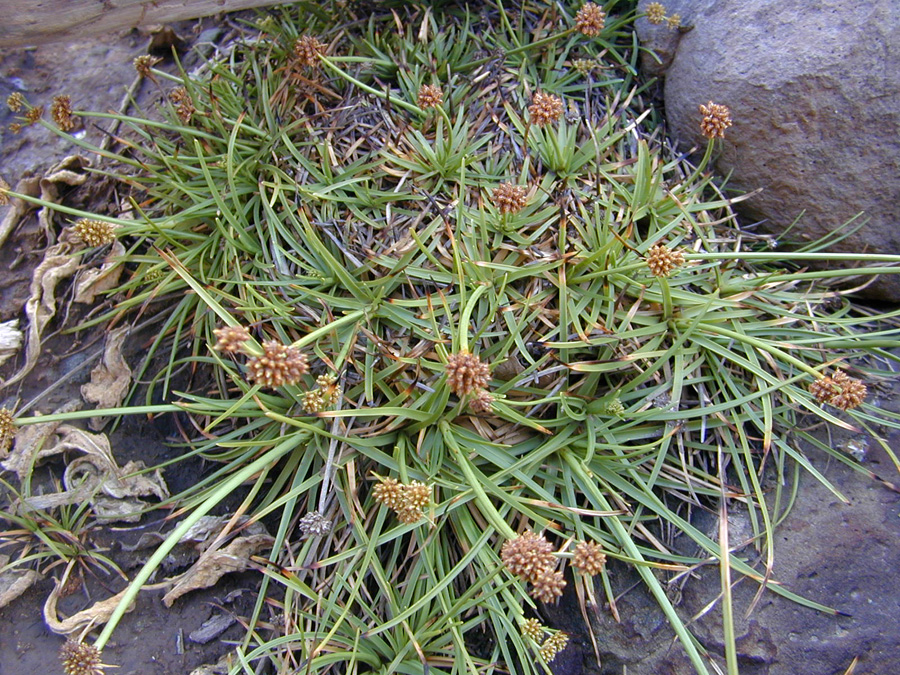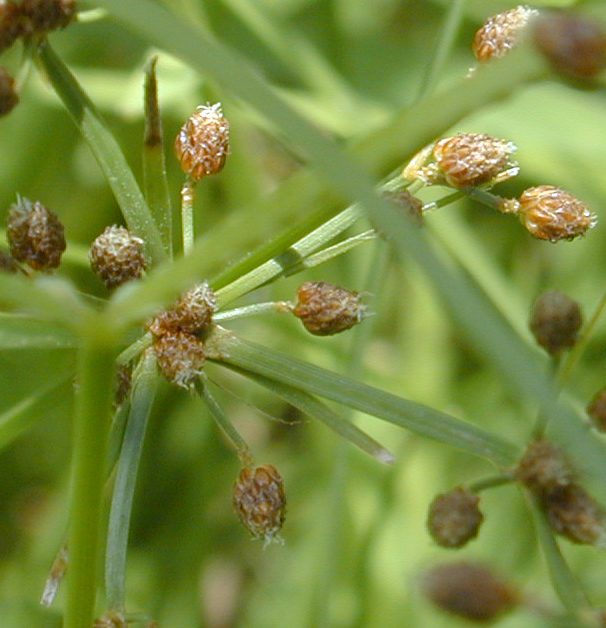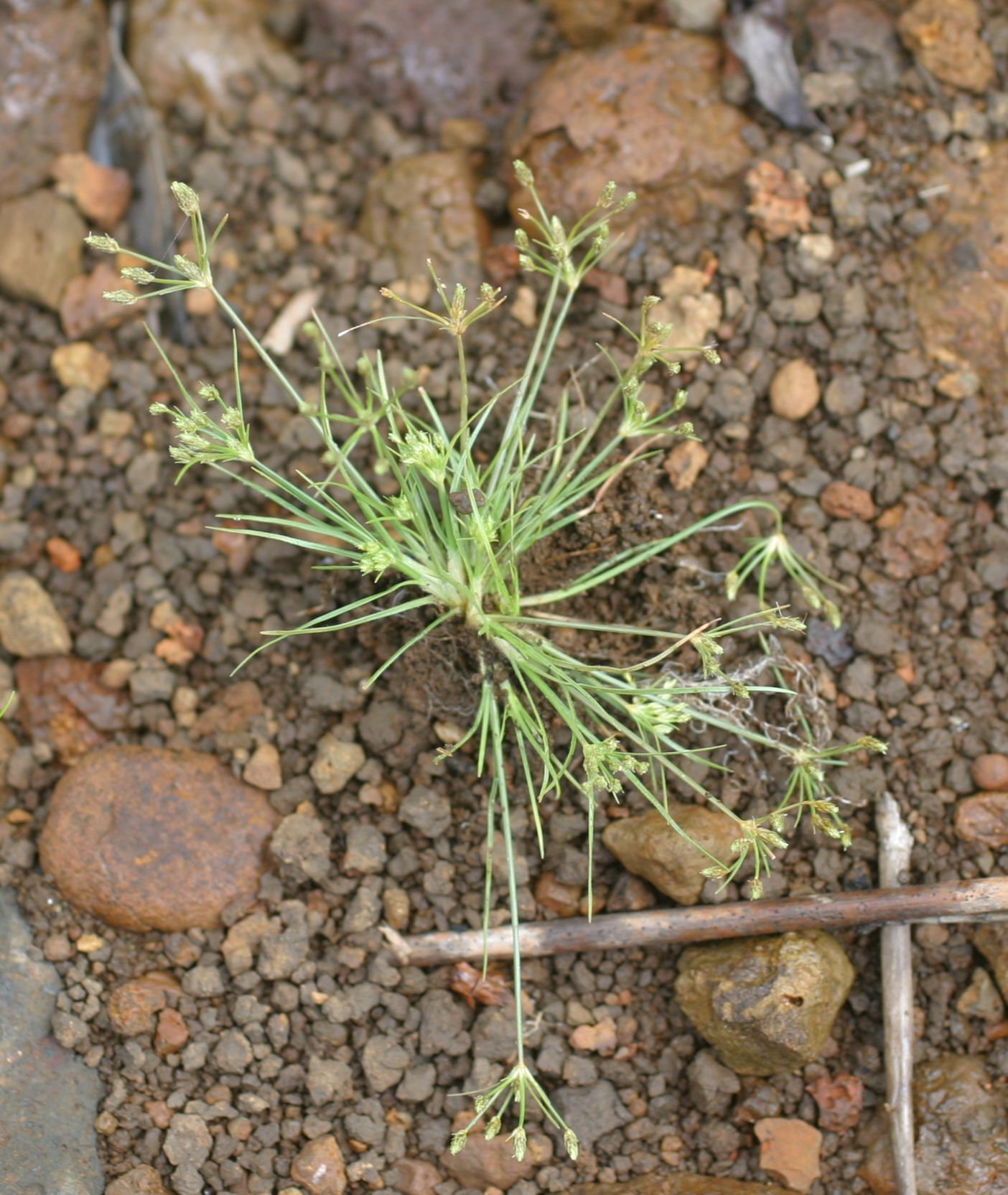|
Key to Genus Fimbristylis
|
|
Sedges in the genus Fimbristylis are small to medium-size plants found in wetlands and fields, with one (F. cymosa) a native, coastal strand inhabitant. These sedges
 resemble generally the more diverse, so-called "flat sedges" (Genus Cyperus), except the spikelets are spindle-shaped (round in cross-section instead of compressed oval), the floral bracts arranged spirally on the rachis.
resemble generally the more diverse, so-called "flat sedges" (Genus Cyperus), except the spikelets are spindle-shaped (round in cross-section instead of compressed oval), the floral bracts arranged spirally on the rachis.
Figure 34A. Guam and Hawai‘i native coastal sedge, mau‘u ‘aki‘aki (Fimbristylis cymosa umbellato-capitata).
For identification purposes, in addition to the overall structure of the inflorescence, pay attention to the leaf blades (present or absent), flattened or narrow (filiform), and the involucral bracts that lie just under (subtend) the inflorescence, which may be all shorter or some longer than the inflorescence.
The genus in Hawai‘i is represented by 8 taxa (7 recognized species, one with 2 subspecies); three of the species are native sedges (Wagner, et al., 1990); at least five are found in wetlands (Erickson & Puttock, 2006). Raulerson (2006) lists 8 species occuring in the Marianas, with 7 of these found on Guam—F. boninensis is found on some smaller, Northern Marianas Islands. Seven of the eight are considered indigenous species in the Marianas.
|
|
|
|
[GENUS FIMBRISTYLIS]
|
|
|
|
|
30a
|
(22)
|
Spikelets clearly longer than wide, tapering towards the top. Leaves variable. Styles either flattened or thread-like, bifid or trifid .. .
|
|
[31] |
|
30b
|
|
 Spikelets ovoid, obovoid, or spherical (globose) in shape, only a little longer than wide. Leaves with or without blades (in which case, sheaths only present). Styles either bifid or trifid .. .
Figure 34B. Fimbristylis inflorescence with ovoid spiklets terminal on filiform rays.
|
|
[39] |
|
~~~~~~~~~~~~~~~~~~~~~~~~~~~~~
|
|
31a
|
(30)
|
Inflorescence of several, unbranched filiform rays up to 3 cm (~1 in) long, each terminated in a single spikelet or at most by a pair; (some rays may be minimally branched) .. .
|
|
[32] |
|
31b
|
|
Inflorescence more complex with numerous spikelets arrayed digitally or spicately on multiple branches or clustered in dense heads .. .
|
|
[36] |
|
~~~~~~~~~~~~~~~~~~~~~~~~~~~~~
|
|
32a
|
(31)
|
Leaf blades narrow (0.5-2 mm [1/16 in] wide), linear-filiform. Inflorescence of several rays, simple or compound; spikelet length variable .. .
| TD>
|
[33] |
|
32b
|
|
Plant to 50 cm tall. Leaf sheaths bilaterally compressed, acutely carinate (ridged) and grooved; leaf blades 3-5 mm across.
Inflorescence of several rays, each teminating in a brown spikelet, or with 2 or 3 spikelets, these 5 mm long. Involucral bracts 2-4, basal one equaling the inflorescence. [GUM - IND] [] Fimbristylis autumnalis tainanensis (Ohwi) T. Koyama.
|
|
~~~~~~~~~~~~~~~~~~~~~~~~~~~~~
[NOTE: THREE CHOICES HERE]
|
|
33a
|
(32)
|
Leaves numerous, mostly basal, shorter than culms, the latter to 70 cm (28 in) and compressed; blades 1-2 mm wide. Inflorescence simple or compound, spikelets 6-10 mm long, each many-flowered. Involucral bracts 2 or 3 and shorter than the inflorescence. { Common savanna plant on Guam [GUM - IND] [FAC]Fimbristylis tristachya R. Brown
| |
|
|
33b
|
|
Leaves mostly spreading, most about half as long as culms; blades very narrow (0.5 mm across). Inflorescence simple or branched. Involucral bracts leafy, shorter or equal to the inflorescence. Spikelets 4-5 mm long; midrib of bracteoles extended, curved outwards. { Volcano, Hawai‘i Island [HAW - NAT] Fimbristylis squarrosa Vahl
| |
|
|
33c
|
|
Plants overall smaller, more delicate, although culms may reach 40 cm (16 in) in height. Leaf blades very narrow, under 1 mm across. Inflorescence generally simple with only a few, unbranched rays per culm or with some branched. Spikelets borne singly, 5 mm or greater in length with few (10 or less) florets.
|
|
[34] |
|
~~~~~~~~~~~~~~~~~~~~~~~~~~~~~
|
|
34a
|
(33) |
 Small (culms 3-12 cm tall), tufted sedge; leaves few, under 1 mm wide. Inflorescence comprising 3 to 7 filiform rays, each terminating in but a single pale spikelet, 2.5-5(7) mm (less than to 1/4 in) in length, long-tapering to a point. { Small annual in wet places on the Islands of Hawai‘i, O‘ahu, and Kaua‘i [HAW - NAT] [FACW] Small (culms 3-12 cm tall), tufted sedge; leaves few, under 1 mm wide. Inflorescence comprising 3 to 7 filiform rays, each terminating in but a single pale spikelet, 2.5-5(7) mm (less than to 1/4 in) in length, long-tapering to a point. { Small annual in wet places on the Islands of Hawai‘i, O‘ahu, and Kaua‘i [HAW - NAT] [FACW]Fimbristylis aestivalis (Retz.) Vahl
|
|
|
34b
|
|
Leaves generally few in number; blades 1 mm or less across. Inflorescence simple, of 3 or 4 rays, each teminating in a spikelet, or rarely with a second, lower spikelet, these 5 mm or longer. { Uncommon sedges on the Island of Hawai‘i .. .
| |
[35] |
|
~~~~~~~~~~~~~~~~~~~~~~~~~~~~~
|
|
35a
|
(34) |
Plants 5-40 cm tall. Leaves few, narrow (0.5-1 mm wide). Spikelets orange-brown, 5-14 mm long; involucral bracts 2 or 3 and shorter than the inflorescence. { Small short-lived perennial in wet places in Hilo, Hawai‘i only [HAW - NAT] [FACW]Fimbristylis schoenoides (Retz.) Vahl
| |
|
|
35b
|
|
Plant 9-17 cm tall. Leaves few, blades channeled, margins incurved, 0.5-1 mm across. Spikelets two-tone brown, 5-9 mm long. Involucral bracts 2 or 3, some barely exceeding the inflorescence. { Small perennial, rare as a pioneer on pahoehoe on Kilauea, Hawai‘i only [HAW - END] [UPL] Fimbristylis hawaiiensis Hillebr.
|
|
|
|
~~~~~~~~~~~~~~~~~~~~~~~~~~~~~
|
|
36a
|
(31)
|
Culms erect, up to 2 or 3 ft (1 m) tall. Spikelets 1/8 in up to 1/2 in (4 to 14 mm) long. Flower style flattened, the margins distinctly fimbriate. Achene over 1 mm in length .. .
|
|
[38] |
|
36b
|
|
Plant a low tuft of often dark leaves, with stiff, blunt tipped blades up to 1/8-in wide and culms under 2 ft (60 cm) tall. Inflorescence either simple or compound, or condensed (headlike). Spikelets 3 to 6 mm long. Style flattened hardly at all, margins not fimbriate. Achene 1 mm or less in length. { Two widely spread subspecies growing in coastal sites (see Figure D) starting not far inland from the normal wash of waves. mau‘u ‘aki‘aki. F. cymosa .. .
|
|
[37] |
|
~~~~~~~~~~~~~~~~~~~~~~~~~~~~~
|
|
37a
|
(36)
|
Inflorescence branches (rays) 1 to 2 in (2-5 cm) long; spikelets in clusters of 2 to 5, or solitary. Styles bifid. mau‘u ‘aki‘aki [HAW - IND] [GUM - IND] [FACU] Fimbristylis cymosa spathacea (Roth) T. Koyama
|
|
|
37b
|
|
Inflorescence typically a single terminal head or sometimes with 2 or three smaller heads of crowded spikelets (see Fig. 34A, above). Rays (if present) under 1 in (1-2 cm) in length. Styles trifid. mau‘u ‘aki‘aki [HAW - IND] [GUM - IND] [FACU] Fimbristylis cymosa umbellato-capitata (Hillebr.) T. Koyama
|
|
|
|
~~~~~~~~~~~~~~~~~~~~~~~~~~~~~
|
|
38a
|
(36)
|
Culm trigonous. Spikelets 1 to 3 terminating ascending branches 2-10 cm (1-4 in) long; lowest involucral bract usually longer than inflorescence. Spikelets 1/8 to 1/3 in (4 - 8 mm) long and pale reddish brown. Floral bracts without hairs. { Found mostly in upland areas of moist soil.
[HAW - IND] [GUM - IND] [FAC] Fimbristylis dichotoma (L.) Vahl.
|
|
|
|
38b
|
|
Culm rounded (terete) but flattened near tip, up to 1 m (3 ft) tall. Spikelets on short, mostly simple branches subtended by 2-6 involucral bracts 1-7 cm long. Spikelets 6-12 mm (1/4 to 1/2 in) long and dark reddish brown. Floral bracts with silvery hairs at least at tips.
{ Found in wetlands. West Indian fimbry [HAW - NAT] [OBL] Fimbristylis ferruginea (L.) Vahl
|
|
|
|
~~~~~~~~~~~~~~~~~~~~~~~~~~~~~
|
|
39a
|
(30)
|
Densely tufted sedge, 40-100 cm tall, with 2-3 bladeless leaves, the sheaths set obliquely at the base. Inflorescence partly compound umbel with generally few spikelets, these 3-4 mm long. Styles variable. Involucral bracts short, about 1 cm long. { Wetland sedge [GUM - IND] [OBL] Fimbristylis globulosa (Retz.) Kunth
|
|
39b
|
|
Tufted annual, 15-70 cm tall. Leaves mosly cauline, long and narrow (1-3 mm by 15-40 cm). Inflorescence of few to many spikelets terminating unequal branches and subtended by 2-4 leaf-like bracts much shorter than the inflorescence. Spikelets 1.5 to 5 mm long, dark red-brown in color. Styles trifid. { Wetland sedge found in ponds and along streams [HAW - NAT] [GUM - IND] [OBL] Fimbristylis littoralis Gaud.
|
|
|
|
Selected synonyms for species included or expected on this page:
Fimbristylis miliacea(L.) Vahl. (= F. littoralis Gaud.)
Fimbristylis ovata (Burm. f.) Kern (= Abildgaardia ovata (Burm. f.) Kral)
|
|
>
|
|
|
 HAW TABLE OF CONTENTS HAW TABLE OF CONTENTS
 GUM TABLE OF CONTENTS GUM TABLE OF CONTENTS
 INFLORESCENCE TYPES INFLORESCENCE TYPES
 AECOS, Inc. AECOS, Inc.
|
|